
Why Diets Fail
Book details
Summary
Description
Look around you. The vast majority of people in the United States are overweight, and a growing number are obese. Rich, poor, old, young, male, female—we see obesity happening across all social domains, races, and ages. Body-weight problems aren’t restricted to certain groups of people. Right now, more than 60 percent of Americans are overweight, and more than 30 percent are obese.1 And these numbers are projected to continue to rise. In fact, by 2030, researchers have predicted that 42 percent of Americans will be obese.2 This is not just something that is occurring within the United States either; the obesity epidemic is a global problem.
Although many of us may want to lose weight simply to improve our appearance or how we feel about ourselves, there are important medical reasons for controlling body weight. Excess body weight has been associated with a number of health risks, including cancer, heart disease, and diabetes. Despite these potential harmful consequences and public health warnings regarding the dangers of obesity, many people continue to overeat. And this isn’t hard to do. High-calorie, high-sugar food is easily accessible to many people today, and portion sizes have increased dramatically over the years. Food is also a big part of our social lives and, as you will read in later chapters, has taken on a new role in our society.
It didn’t used to be this way. Fifty years ago, it was much less common to see fat people and usually a rarity to see fat children. So, what happened to cause such an abrupt and dramatic change in the waistline of society? Certainly, social factors made it easier to stay slim ?fty years ago. There were more stay-at-home moms to prepare healthy, wholesome, homemade meals; more people smoked cigarettes (which are appetite suppressants); and, importantly, there weren’t as many food choices or the large portions we have today.
lead one to think that we should be healthier, not heavier. There have been dramatic advances
in the diagnosis and treatment of diseases, like cancer and heart disease. We have learned an
incredible amount from scientists about ways in which we can live healthier, longer lives. And
we have so many luxuries that should make losing weight and staying well easy: We have
twenty-four-hour gyms, a variety of health food stores and healthy food choices, and even an
array of “diet” foods and programs that are supposed to help us keep our body weight in
check. Low-fat, low-carb, no-carb—there are so many di?erent plans out there that you could
spend a lifetime trying them all. Dieting is a multibillion-dollar industry. With all of the books,
magazine articles, and television programs focused on weight loss, it is really a wonder how
overeating could be such a looming problem, not only in the United States but throughout the
world.
Why is this happening? Why can’t people just stop eating so much and lose weight? Many
possible culprits have been identi?ed. Sure, people are stressed and lead relatively sedentary
lifestyles, and this undoubtedly contributes to the problem of overeating. Also, genetics play a
role; overweight people will give their genes (and thus perhaps a tendency to be overweight)
to their children, and they might also raise them in a home that promotes excess food intake or
unhealthy eating habits. But there is more to it than just these factors.


We would LOVE it if you could help us and other readers by reviewing the book
Book review



